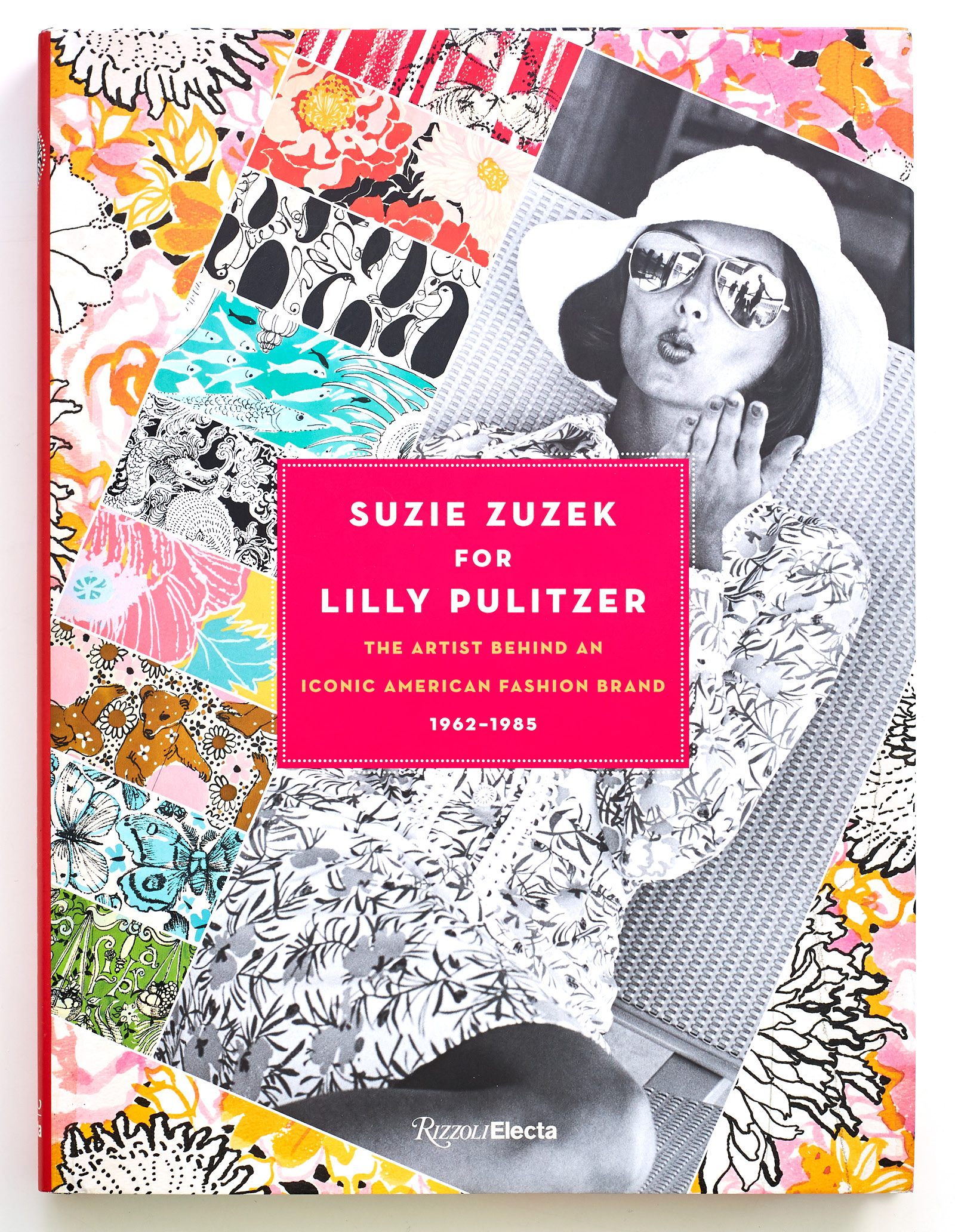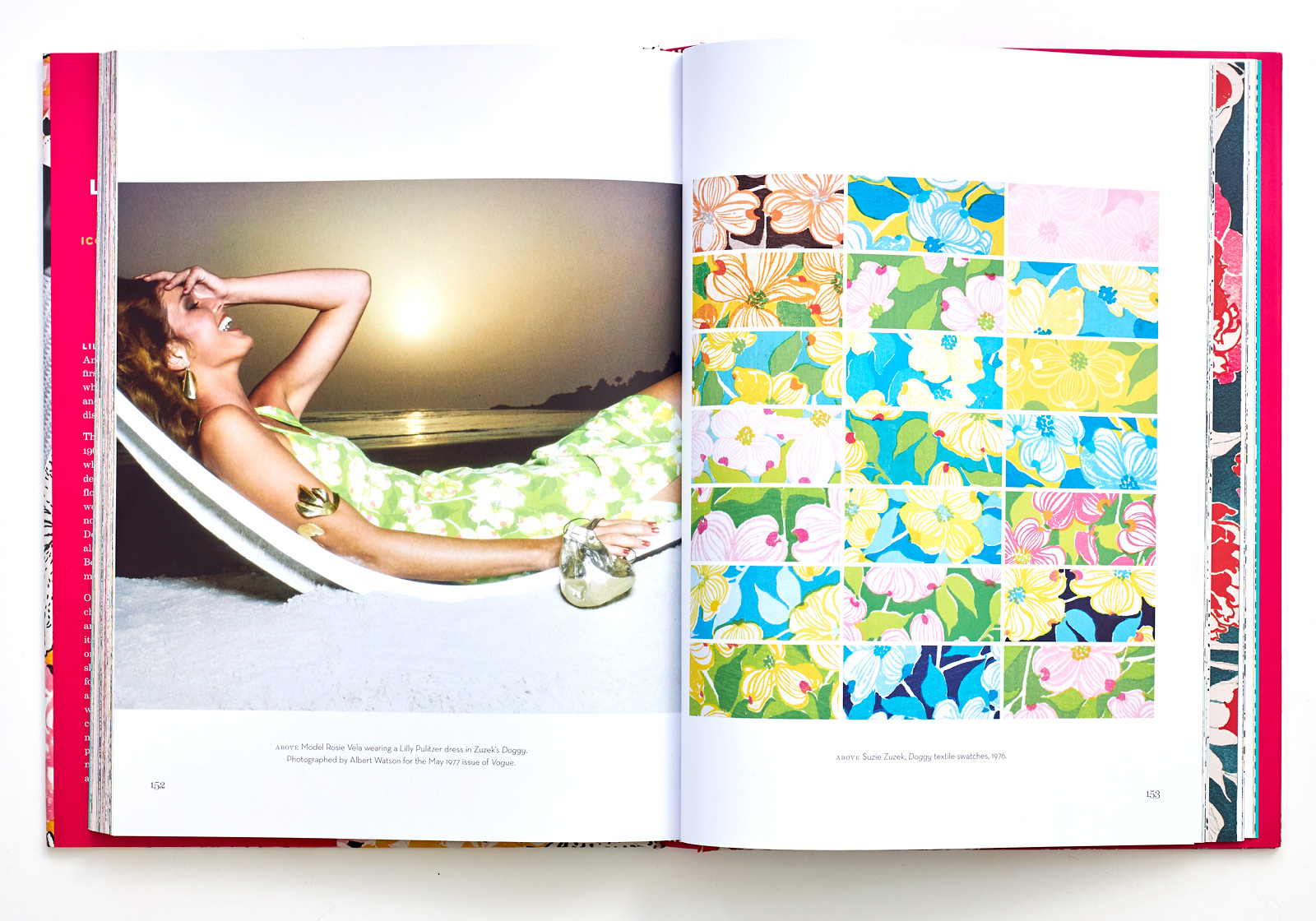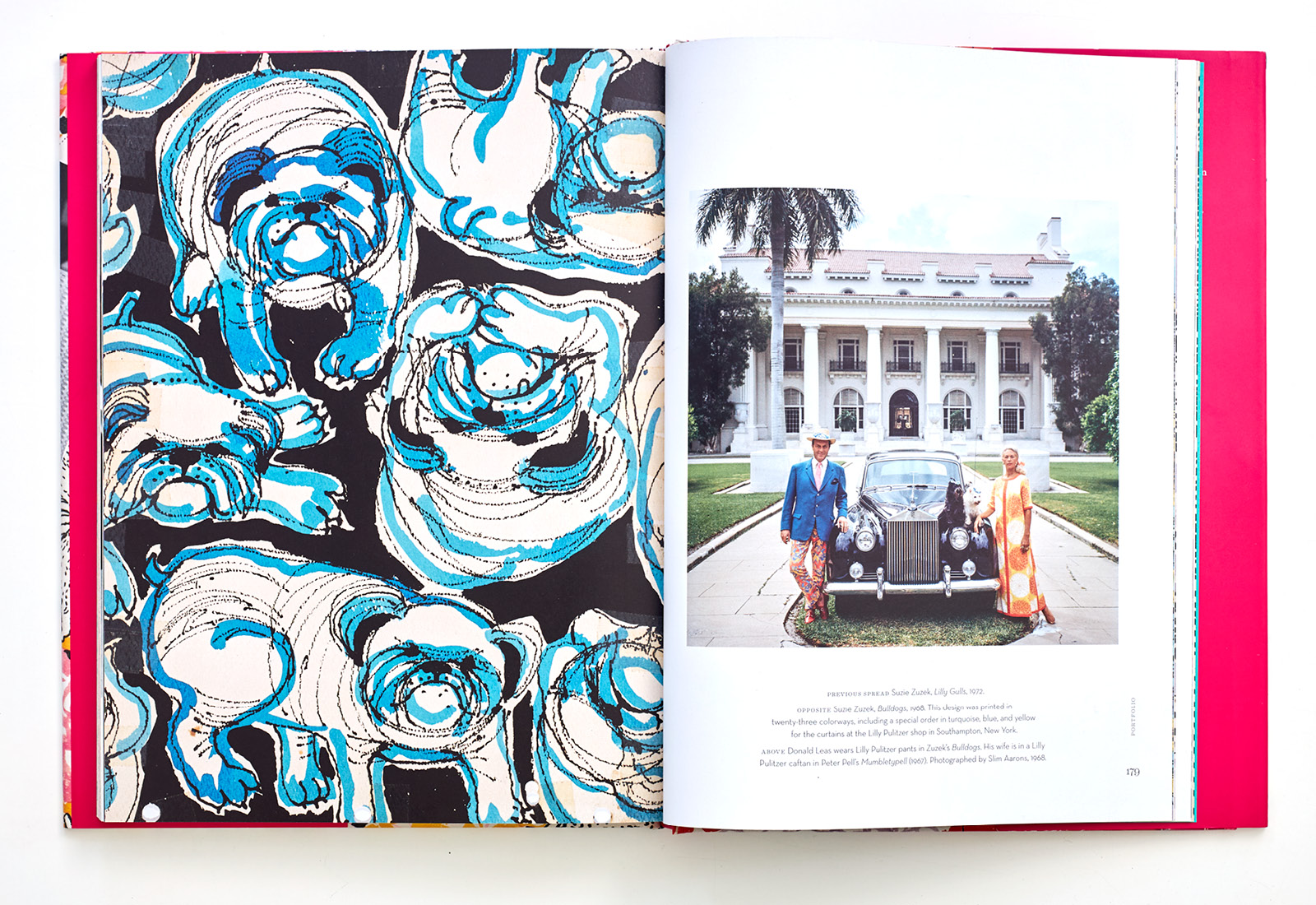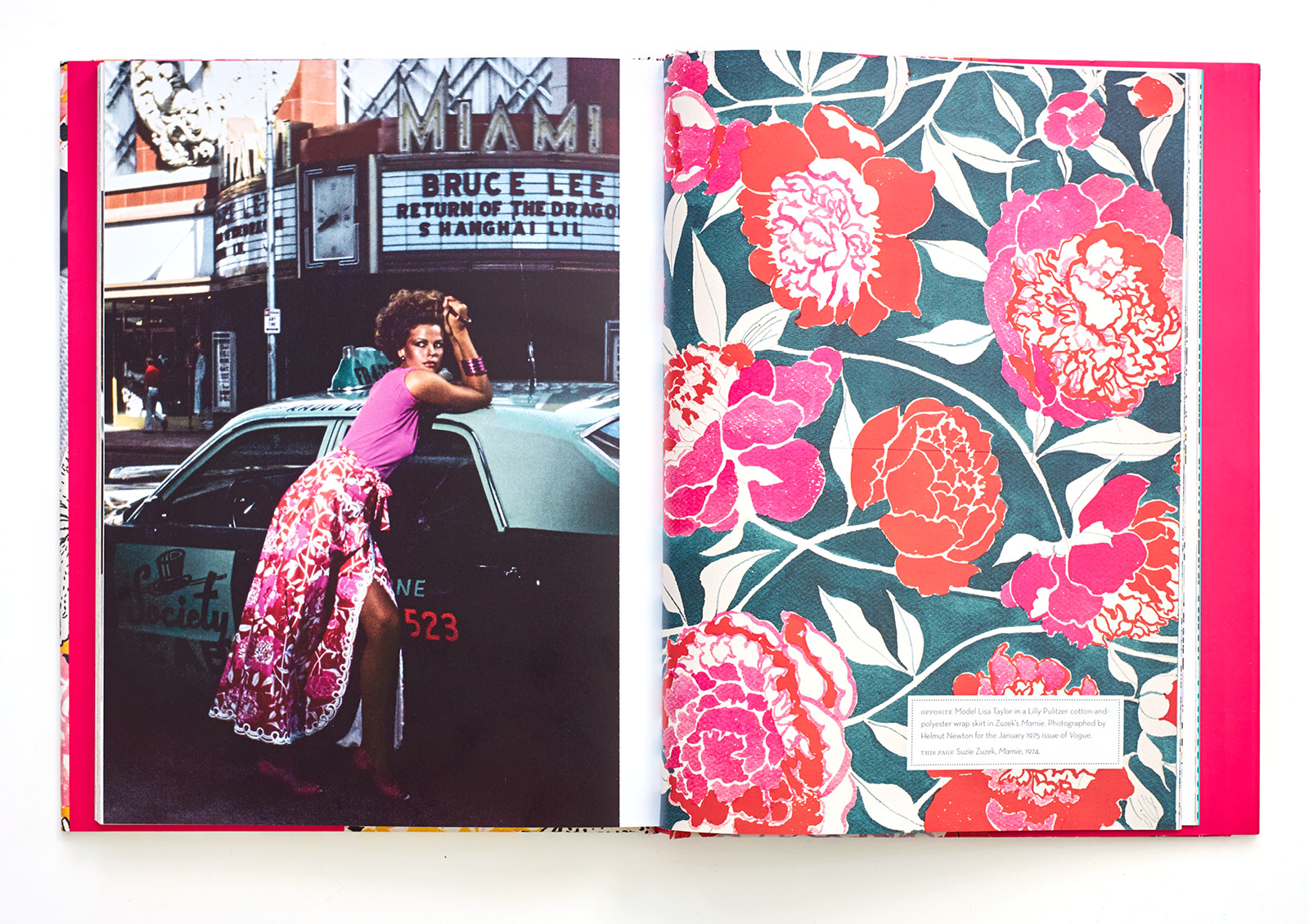
If you’ve seen some of my design projects or read my blog, it won’t take you long to understand that my world is full of colorful interiors and fashion. Palm Beach has been part of my life, on and off and on again, since Day 1. Perhaps that is why I am so drawn to intensely vibrant tropical hues, especially in printed fabrics. “What is old is new again” rings true with my lifelong love for vintage prints and patterns, especially those of Lilly Pulitzer in the original 1960s and ’70s complexion of vibrancy and charm. My sister and I wore the original prints throughout childhood. We loved skipping through the Lilly shop in Palm Beach. It was full of colorful prints we all love, as well as handbags, pouches, and stuffed animals—all made from the ubiquitous prints.
When I learned a new book from Rizzoli, Suzie Zuzek for Lilly Pulitzer: The Artist Behind an Iconic American Brand, 1962–1985, celebrates the artistry of the Lilly Pulitzer prints, I did a one-two-click on Amazon . The book by Susan Brown and Caroline Rennolds Milbank doesn’t focus on Lilly Pulitzer the person but on Suzie Zuzek, the artist who Lilly credits for imaginative creations that made the colorfully conservative brand iconic in the world of American fashion.
I spoke with author Susan Brown, associate curator of textiles at the Cooper Hewitt in New York. Susan conducted the research for the book and produced the exhibit that the public will be able to enjoy once it’s safe to be together again. Susan flew to Key West to interview family, friends, and employees of Lilly Pulitzer’s company, who described their experiences as joyful and the best jobs they ever had. I imagine so.

I can’t turn back the clock to observe fashion maven Lilly Pulitzer and her behind-the-scene visionary, Suzie Zuzek. I can take the journey through the beautiful book. Here’s my conversation with Susan.
What led to your position at the Cooper Hewitt?
I’ve been at the Cooper Hewitt for 18 years now as the curator of textiles. I oversee a collection that includes more than 26,000 artifacts that span over 24 centuries. I’m never bored because there is always something to learn. There’s no way that I could master one collection in my lifetime. It’s so vast.
I’ve always sewed, made my clothes, and worked with fabrics since I was a toddler. There was always a fascination. But when I worked as a costume designer for the theater and opera, I became interested in historical textiles. There was a lot of research involved with historic fashion and textiles. That’s when I became intrigued by the research component of it and wanted to pursue that full time.
With so many pieces to select from, how much of a challenge is it to create a new exhibition?
It’s extremely difficult because there is so much to work with and not enough time. Exhibitions all take a very different approach. I’ve done exhibits on a single designer. Or the focus could be a specific type of fabric. In recent years, I produced an exhibition on felt. It was becoming popular again and warranted attention. A recent favorite of mine was called Extreme Textiles: Designing for High Performance. This exhibition featured medical and aerospace geotextiles. Textiles exist in so many places that aren’t necessarily considered. As a textile curator, people think that everything I cover is esoteric. But textiles are everywhere. My job encompasses textiles in places that I didn’t imagine.
How did this exhibit happen?
I got involved in the project through Becky Smith, who landed the collection of Suzie Zuzek’s prints. She made an appointment with our curator to see if there was interest in some of the drawings for the permanent collection. Once we acquired 10 pieces, we became engaged with the drawings. It was difficult not to with such a compelling story. And that’s when we decided to produce an exhibition. Also, there is a five-year initiative across all the Smithsonian museums for exhibitions that highlight women’s contributions to American history. This was the case of an unsung American design hero, Suzie Zuzek. Her name is not known, even though her work is.

The storytelling of exhibitions often brings to light a subject that people would never have known about otherwise. What was it about this story that you found especially important to share?
This exhibition acknowledges all of the legions of creative people who work anonymously behind the scenes. Lilly Pulitzer is so closely identified with prints—more so than any other fashion house. Her story is a vivid example of a brand that is identified by one person’s name but represents hundreds of people who work there but are uncredited.
What surprised you in your research for this project?
The number of animal patterns that existed from the vintage textiles! Think about it. Animal prints are relegated to garments for children or for their bedrooms. You wouldn’t normally find adults wearing animal-pattern textiles. Prints from furs and hides, yes. But not patterns of elephants or horses or monkeys. In vintage Lilly Pulitzer, animal patterns were common, both for women and men, and that is quite unique. Also, the original design coloration was created in a way that wasn’t necessarily represented in the end product. Suzie used a lot of black line as her technique for drawing. Lilly Pulitzer, however, forbade the use of black so the coloration is vastly different from the original design intent. The psychedelic movement of the time inspired putting such bold, vibrant colors on garments with silhouettes that were quite conservative. Lilly Pulitzer is famous for dayglow, fluorescent colors that are part of the brand’s ethos. “Lilly follows the sun.” “It’s always summer somewhere.” Those were a couple of her taglines. All about color and joy.
What was it like to work on an exhibition about a brand that bears such an iconic image in America?
Certainly, everyone has an opinion about iconic figures and brands. That is definitely true of Lilly Pulitzer. This was a challenge because there are so many social connotations when it comes to Lilly Pulitzer. The brand has different meanings to different people. Some people are only familiar with the brand’s current iteration, which has little to do with the brand’s origins. So many people think of it as a preppy brand, colored perhaps by the Kennedy White House, Camelot, and everything that moment in history signified. I don’t want to assume that everyone follows or knows the name Lilly Pulitzer. For instance, I am in that age group that would associate the brand with a preppy style. But through my research, I was delighted to see the depth and variety of the original designs. Impressionistic drawings that were so detailed that they were like botanicals, vegetables, seaweed, unicorn tapestries. In the end, I found so much more richness to the textiles than I would have imagined from my own experience with the name Lilly Pulitzer.

We have a daily relationship with textiles because we put on clothes every day. But we don’t think about or understand this category of goods. Why is it important that the consumer be educated about textiles?
First, it’s important for the consumer to understand quality. There are so many people behind the creation of a textile. It’s about appreciating the multitude of people that go into the process. Not only the artist, such as the case of Suzie Zuzek, but also the technicians who are translating that to the end material.
Exhibits aside, what’s one part of the textile category that you particularly love?
One of my personal passions is about the waste in the textile industry. People should be disturbed if they see a $3 T-shirt or a $12 dress. That’s a quick sign that the price is too low for what went into it. Part of consumer education is conveying to people the idea of spending more on garments to maintain a world that is livable.
The exhibition was delayed due to COVID-19 closings, but I’m so excited to see it when it does open. What can I expect?
The exhibition is primarily focused on the original design drawings by Suzie. We show more than 35 original works, along with the processes, such as how a watercolor sketch is translated from artwork to screen printing. There are vintage photographs, a camera, and the physical textiles. It shows the original design drawings by an incredible artist with a beautiful hand and how that translates to the textile.
There is a complexity to the original artwork that is so beautiful. We address the screen process step by step. Color separations, transparencies, pattern repeats—we cover them all. Additionally, the drawings take an interesting spin because they are technical documents with notations, indications where the repeats will be, etc. The designs are all non-directional. These are aspects of textiles that people never consider or understand the importance of, and it’s great to have a teaching moment when whoever is looking at the exhibit or reading the book can walk away with information that they did not know before.
It’s definitely something to look forward to when we are able to enjoy museums again.
In the meantime, check out Suzie Zuzek for Lilly Pulitzer: The Artist Behind an Iconic American Brand, 1962–1985, by Susan Brown and Caroline Rennolds Milbank.

